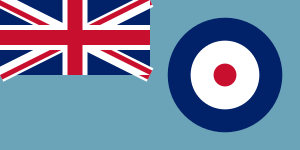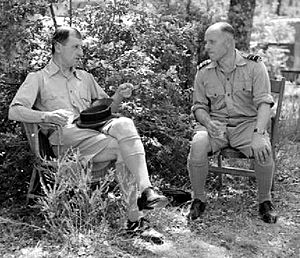Desert Air Force facts for kids
Quick facts for kids Desert Air Force |
|
|---|---|

Ensign of the Royal Air Force
|
|
| Founded | 21 October 1941 |
| Country | |
| Role | Tactical air force |
| Size | over 1,500 combat aircraft (late 1942) |
| Part of | Air Ministry |
| Engagements | Second World War |
| Commanders | |
| Notable commanders |
Arthur Coningham Harry Broadhurst William Dickson |
The Desert Air Force (DAF) was a special group of Allied air forces during World War II. It was formed in North Africa in 1941. Its main job was to fly close to the ground and help the British Eighth Army fight against the Axis forces.
The DAF included planes and pilots from many countries. These were mainly the Royal Air Force (RAF) from the UK, the South African Air Force (SAAF), the Royal Australian Air Force (RAAF), and the United States Army Air Forces (USAAF).
By late 1941, the DAF had about 1,000 combat planes. By the time of the Second Battle of El Alamein, it had grown to over 1,500 planes. This was more than double the number of planes the Axis forces had. The DAF used many types of planes, including bombers like the Boston and Mitchell, and fighters like the Hurricane, Kittyhawk, and Spitfire.
Contents
History of the Desert Air Force
Before the Desert Air Force was officially created, different RAF groups operated in North Africa. In September 1939, when World War II began, the RAF Middle East Command was in charge. It had air forces in Egypt, Iraq, Malta, and Aden.
When Italy joined the war in June 1940, the RAF in the Middle East had fewer than 300 aircraft. These planes were spread across many squadrons. Their main tasks were to support ground troops, scout the area, and fight enemy planes when needed.
Early Days in Egypt
In Egypt, the RAF had bomber squadrons with planes like the Bristol Blenheim. They also had transport planes that could carry troops or act as bombers. These early forces were small. They had to be smart to fight the Italian Regia Aeronautica (Royal Air Force).
For example, they sometimes moved their only Hawker Hurricane fighter plane quickly between different airfields. This made it seem like they had more planes than they did. This trick helped make the Italians think the British were stronger.
Getting new planes to North Africa was hard. It was a 14,000-mile sea journey that took three months. So, a new route was found across Africa from Takoradi in the Gold Coast. New planes arrived by sea, were put together, and then flown across the continent.
By late 1940, more planes arrived, including Hurricanes and Wellington bombers. Several South African Air Force squadrons also joined. This made the RAF stronger for upcoming battles like Operation Compass. During this operation, the planes worked closely with ground forces. They often landed at new, more advanced airfields after their missions.
Forming the Desert Air Force
In April 1941, a new group called No. 204 Group RAF was formed. It brought together many of the squadrons operating in the desert. Later that year, on October 21, 1941, this group was upgraded. It became a full command called Air Headquarters Western Desert. This was the beginning of what would become the Desert Air Force.
The command changed its name briefly to Air Headquarters Libya in January 1942. But it soon went back to being called Air Headquarters Western Desert.
Western Desert Air Force in Action
The Western Desert Air Force (WDAF) played a huge role in the desert war. It was organized into different wings and groups. These included bomber wings, reconnaissance wings (for scouting), and fighter wings.
The WDAF had many types of planes. Bombers like the Martin Baltimore and Douglas Boston were used for attacks. Fighters like the Hurricane, Kittyhawk, and Spitfire provided air cover and attacked ground targets. Reconnaissance planes like the Hurricane and Maryland gathered information.
The US Army Air Forces also sent units to work with the WDAF. These included fighter squadrons with P-40F Warhawks and bomber squadrons with B-25C Mitchells. These American units were a big help to the Allied efforts.
Big Changes and New Names
In January 1943, important leaders like British Prime Minister Winston Churchill and American President Franklin D. Roosevelt met. They decided to reorganize all the Allied air forces in North Africa and the Mediterranean.
The Western Desert Air Force became part of a larger command called the Northwest African Tactical Air Force. On July 10, 1943, when the Allies invaded Sicily (Operation Husky), the Western Desert Air Force was officially renamed the Desert Air Force (DAF).
The DAF continued to provide vital support to the British Eighth Army. It helped ground forces in Egypt, Libya, Tunisia, Sicily, and mainland Italy. The successful ways the DAF supported ground troops became a model for other air forces. The DAF continued to operate until June 1946.
Aircraft Used by the DAF

At first, the Desert Air Force often received older aircraft. This was because defending Britain itself was the top priority. So, the DAF started with planes like the Gloster Gladiator biplane fighter and the Bristol Blenheim light bomber. Even with these older planes, they did well against the Italian Air Force, which also had older aircraft.
As the war went on, newer planes were sent to the DAF. In 1941, they received the Hawker Hurricane fighter and the Douglas Boston medium bomber.
American-built planes like the P-40 Tomahawk and Kittyhawk also joined the DAF. These planes were great for ground attack missions. They were not as good for high-altitude fights in Europe, but they were perfect for the desert.
The DAF usually had more planes than its Axis enemies. They focused on attacking enemy targets far away and directly helping the Eighth Army. Sometimes, this meant their planes flew low and slow. This made them targets for faster German planes like the Messerschmitt Bf 109.
In 1942, the DAF changed its tactics and got better planes. Spitfire fighters became operational in August 1942. These faster planes helped the DAF gain control of the skies.
The DAF also improved how it supported ground troops. They used fighter-bombers that could talk to "forward air controllers" on the ground. These controllers were with the army units and could call for air support when needed. The DAF even created "cab ranks" of fighter-bombers. These were planes waiting in the air, ready to be called into action instantly. These smart tactics were later used with great success in the Invasion of Europe in 1944.
People of the Desert Air Force

Many different people served in the DAF. The SAAF provided over a dozen squadrons. For South Africa, the desert was their main area of operations. Between April 1941 and May 1943, SAAF squadrons flew almost 34,000 missions. They claimed to have destroyed 342 enemy aircraft.
Australia also made a big contribution. No. 3 Squadron RAAF arrived in North Africa in late 1940. It served with the DAF for most of the war. This squadron had one of the best service records in the DAF. Many Australian pilots also flew with British or South African squadrons.
Pilots from countries occupied by Germany, especially Polish airmen, also flew in DAF squadrons. For example, No. 112 Squadron RAF had many Polish pilots. In 1943, a famous group called the Polish Fighting Team (also known as "Skalski's Circus") joined No. 145 Squadron RAF.
From July 1942, the United States Army Middle East Air Force (USAMEAF) sent American personnel to DAF units. They were officially "observers" at first. Later, US P-40 Warhawk and B-25 Mitchell squadrons officially joined DAF units.
British and Commonwealth personnel who served with the DAF received a special medal. It was called the Africa Star campaign medal.
Commanders of the DAF
Here are some of the important leaders who commanded the Air Headquarters Western Desert or the Desert Air Force:
- AHQ Western Desert
- Air Vice-Marshal Arthur Coningham (October 1941 – January 1943)
- Air Vice-Marshal Harry Broadhurst (January 1943 – July 1943)
- Desert Air Force
- Air Vice-Marshal Harry Broadhurst (July 1943 – April 1944)
- Air Vice-Marshal William Dickson (April 1944 – December 1944)
- Air Vice-Marshal Robert Foster (December 1944 – August 1945)
- Air Commodore Colin Falconer (August 1945 onwards)
See also
- Balkan Air Force
- List of North African airfields during World War II
- List of Royal Air Force commands
Images for kids




